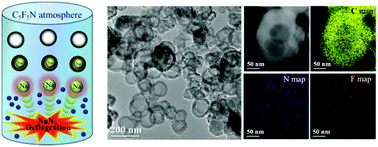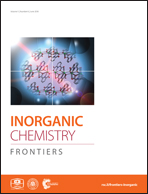Deflagration synthesis of nitrogen/fluorine co-doped hollow carbon nanoparticles with excellent oxygen reduction performance†
Abstract
Critical factors such as doping content, electronic conductivity and porosity need to be addressed to obtain excellent oxygen reduction reaction (ORR) performance with metal-free carbon-based materials. However, creating a facile approach to obtain carbon materials with a high doping level, high graphitization degree and high surface area still remains a great challenge. In this work, we develop a NaN3/C5F5N deflagration method to synthesize high N/F co-doped carbon hollow nanospheres (N/F-HC) with a high graphitization degree. The deflagration of NaN3 can produce Na nanoclusters, which can not only capture partial F atoms from C5F5N but can also be used as templates for the formation of a hollow structure. The heat liberation from deflagration and the subsequent F-capturing reaction could generate an extremely high temperature for graphitic structure formation. Moreover, the ultra-fast deflagration and F-capturing reaction allow carbon growth to be completed in seconds, which can ensure a high N/F doping content. The optimized N/F-HC catalyst exhibits superior ORR performance with long-term stability compared to a commercial Pt/C electrocatalyst in an alkaline medium. The synthetic strategy described in this work is facile and is expected to underpin future research efforts to develop metal-free electrocatalysts for the ORR and other applications.



 Please wait while we load your content...
Please wait while we load your content...